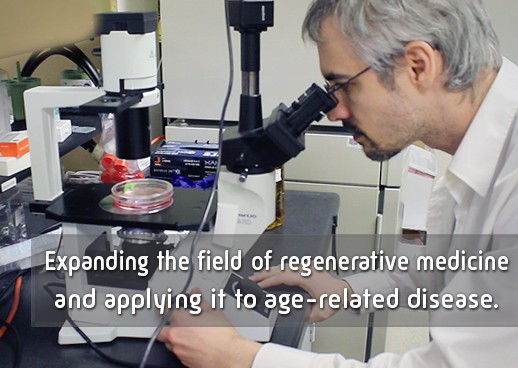Rejuvenation Research at the SENS Research Foundation
The Strategies for Engineered Negligible Senescence Research Foundation, or SRF, is a non-profit organization founded in 2009. Its co-founders include Aubrey de Grey, Jeff Hall, Michael Kope, Sarah Marr and Kevin Perrott. SRF’s primary purpose is research and public relations in human rejuvenation, which is also the goal of the Methuselah Foundation.
Overview
The effects of aging generally result from unrepaired cellular damage that accumulates over a long period of time. The body’s functions become progressively more compromised as cellular structures fail, leading to the disabilities and diseases associated with aging. The SRF’s goal is to discover new ways of repairing age-related damage and reverse the effects of age. These technologies will restore normal cellular functioning to return the body back to its youthful state. The SRF is currently investigating the following specific areas of research in rejuvenation:
• Extracellular aggregates
• Death-Resistant cells
• Extracellular crosslinks
• Intracellular aggregates
• Mitochondrial mutations
• Nuclear mutations
• Cell loss and atrophy
• Delivery systems
Extracellular Aggregates
Extracellular aggregates primarily consist of proteins that no longer serve any purpose, although their presence impairs the functioning of healthy cells. This material is typically described as “amyloid” and is different from extracellular cross-linking. The most effective method of removing extracellular aggregates is to use specialized antibodies in the form of vaccines. A passive vaccine involves injecting the antibodies directly into the body, while an active vaccine introduces a small amount of amyloid material to stimulate the body’s own antibodies to attack that material.
Death-Resistant Cells
Some cells in the body are programmed to respond to conditions that place the body at risk, causing them to undergo transformations that allow them to deal with these short-term risks. However, these transformed cells can also cause long-term damage when they begin to accumulate in the body. The two primary methods of removing abnormal cells include using a drug that destroys them without harming normal cells and stimulating the body’s immune system to selectively target abnormal cells.
Extracellular Crosslinks
Many structures in the body are composed of proteins that are recycled very slowly. These proteins need to maintain their original structure to perform their proper functioning, but other chemicals such as sugars can bond with these proteins to change their structure. These bonds are known as extracellular crosslinks, which may be severed with designer drugs that don’t affect the rest of the protein.
Intracellular Aggregates
Intracellular aggregates are damaged cellular constituents that accumulate within the cell, which can eventually impair that cell’s functions. Lysosomes are one type of cellular body that removes intracellular aggregates by breaking them down with powerful enzymes, although the body’s own lysosomes aren’t able to break down all intracellular aggregates. The lysosomes in soil bacteria may contain enzymes that can break down additional aggregates and reverse the effects of aging.
Mitochondrial Mutations
Mitochondria are cellular bodies that convert food into chemical energy, which drives the biochemical reactions within the body. They have their own form of DNA known as mtDNA that’s separated from the rest of the cell’s DNA, which is kept in the nucleus. Mitochondrial DNA is more vulnerable to mutations caused by free radicals, so another strategy in SENS research is to store copies of mtDNA within the nucleus.
Nuclear Mutations
Changes to DNA can also cause aging effects and may be classified into two categories, including mutations and epimutations. A mutation is a change to the DNA itself while an epimutation is a change to the mechanism that determines when a gene expresses itself. SENS research on mutations looks for ways to remove the genes that cause cells to become cancerous.
Cell Loss and Atrophy
Cells can atrophy when they’re no longer able to divide, which forces them into a dysfunctional state known as senescence. Stem cells are specialized cells that repair senescent cells for a particular type of tissue, but this process becomes less effective with age. One solution to this problem is tissue engineering, which involves growing organs and other tissue outside the body until they can be transplanted into a patient.
Delivery Systems
Rejuvenation therapies often involved the administration of proteins, which are large molecules. They typically can’t be swallowed in pill form, because proteins will be broken down by digestive enzymes in the stomach and other metabolic processes. One solution to this problem is to cause tissues in the body to produce therapeutic proteins, either by transplanting engineered tissue or engineering existing tissue to produce these proteins in a process known as somatic gene therapy.
Sources: http://sens.org/research/introduction-to-sens-research, http://sens.org/, http://www.methuselahfoundation.org/,

